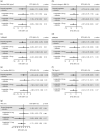Effect of liraglutide treatment on body mass index and weight parameters in children and adolescents with type 2 diabetes: Post hoc analysis of the ellipse trial
- PMID: 33634589
- PMCID: PMC8277686
- DOI: 10.1111/ijpo.12778
Effect of liraglutide treatment on body mass index and weight parameters in children and adolescents with type 2 diabetes: Post hoc analysis of the ellipse trial
Abstract
Background: Weight loss in children and adolescents with type 2 diabetes (T2D) is associated with improved glycaemic control.
Objectives: To assess the effects of liraglutide vs placebo on body mass index (BMI) and weight parameters in children and adolescents with T2D using data from the ellipse trial (NCT01541215).
Methods: The ellipse trial randomized participants (10-<17 years old, BMI >85th percentile, T2D, glycated haemoglobin [HbA1c ] 7.0%-11.0% [if diet- and exercise-treated] or 6.5% to 11.0% [if treated with metformin, basal insulin or both]) to liraglutide or placebo. This post-hoc analysis evaluated changes from baseline to weeks 26 and 52 in absolute BMI, percent change in BMI and other weight-related parameters. Changes were assessed by liraglutide overall (all doses) and liraglutide by dose (0.6, 1.2 and 1.8 mg/day) vs placebo using a pattern mixture model of observed data, with missing observations imputed from each treatment group.
Results: In total, 134 participants were included. There were statistically significant differences between groups in certain parameters, including absolute BMI (estimated treatment difference [ETD] -0.89 kg/m2 ; 95% confidence interval [CI] -1.71,-0.06) and percent change in BMI (ETD -2.73%; 95% CI -5.15,-0.30) at week 52, but none at week 26. Dose-dependent effects were not observed for liraglutide vs placebo for all BMI/weight parameters.
Conclusions: Compared with placebo, liraglutide was associated with statistically significant reductions in BMI/weight parameters at week 52, but not week 26, in children and adolescents with T2D.
Keywords: anti-obesity agents; body mass index; liraglutide; paediatric obesity; weight.
© 2021 World Obesity Federation.
Conflict of interest statement
M.O.B. receives research support from Vivus Inc and serves as a site principal investigator.
E.M.B. serves as a site principal investigator for Novo Nordisk.
C.T.B. was funded by the National Institutes of Health's National Center for Advancing Translational Sciences, grants KL2TR002492 and UL1TR002494. The content is solely the responsibility of the authors and does not necessarily represent the official views of the National Institutes of Health's National Center for Advancing Translational Sciences. T.V.S.D., P.M.H. and C.K.R. are full‐time employees of Novo Nordisk; CKR and PMH also hold shares in Novo Nordisk.
KDR has no conflicts of interest to disclose.
ASK serves as an unpaid consultant for Novo Nordisk, Vivus and WW (formerly Weight Watchers), and receives drug/placebo from AstraZeneca for an NIDDK‐funded clinical trial.
Figures

Similar articles
-
Efficacy of liraglutide added to sodium-glucose cotransporter-2 inhibitors in type 2 diabetes, stratified by baseline characteristics: Post-hoc analysis of LIRA-ADD2SGLT2i.Diabetes Obes Metab. 2021 Oct;23(10):2234-2241. doi: 10.1111/dom.14464. Epub 2021 Jul 8. Diabetes Obes Metab. 2021. PMID: 34132018 Free PMC article. Clinical Trial.
-
Insulin degludec/liraglutide (IDegLira) was effective across a range of dysglycaemia and body mass index categories in the DUAL V randomized trial.Diabetes Obes Metab. 2018 Jan;20(1):200-205. doi: 10.1111/dom.13043. Epub 2017 Jul 31. Diabetes Obes Metab. 2018. PMID: 28643425 Free PMC article. Clinical Trial.
-
Evaluating potential predictors of weight loss response to liraglutide in adolescents with obesity: A post hoc analysis of the randomized, placebo-controlled SCALE Teens trial.Pediatr Obes. 2023 Sep;18(9):e13061. doi: 10.1111/ijpo.13061. Epub 2023 Jun 1. Pediatr Obes. 2023. PMID: 37264767 Free PMC article. Clinical Trial.
-
Improvement in glycated haemoglobin evaluated by baseline body mass index: a meta-analysis of the liraglutide phase III clinical trial programme.Diabetes Obes Metab. 2016 Jul;18(7):707-10. doi: 10.1111/dom.12617. Epub 2016 Feb 2. Diabetes Obes Metab. 2016. PMID: 26662611 Free PMC article. Review.
-
Long-term efficacy and safety comparison of liraglutide, glimepiride and placebo, all in combination with metformin in type 2 diabetes: 2-year results from the LEAD-2 study.Diabetes Obes Metab. 2013 Mar;15(3):204-12. doi: 10.1111/dom.12012. Epub 2012 Oct 11. Diabetes Obes Metab. 2013. PMID: 22985213 Review.
Cited by
-
Intervention with Therapeutic Agents, Understanding the Path to Remission to Type 2 Diabetes: Part 2.Endocrinol Metab Clin North Am. 2023 Mar;52(1):39-47. doi: 10.1016/j.ecl.2022.07.004. Epub 2022 Nov 18. Endocrinol Metab Clin North Am. 2023. PMID: 36754496 Free PMC article. Review.
-
Youth-onset Type 2 Diabetes: An Overview of Pathophysiology, Prognosis, Prevention and Management.Curr Diab Rep. 2024 Aug;24(8):183-195. doi: 10.1007/s11892-024-01546-2. Epub 2024 Jul 3. Curr Diab Rep. 2024. PMID: 38958831 Free PMC article. Review.
-
Risk Factors, Clinical Consequences, Prevention, and Treatment of Childhood Obesity.Children (Basel). 2022 Dec 16;9(12):1975. doi: 10.3390/children9121975. Children (Basel). 2022. PMID: 36553418 Free PMC article. Review.
-
Drug dosing in children with obesity: a narrative updated review.Ital J Pediatr. 2022 Sep 8;48(1):168. doi: 10.1186/s13052-022-01361-z. Ital J Pediatr. 2022. PMID: 36076248 Free PMC article. Review.
-
Glucagon-like Peptide-1 Receptor Agonists for the Treatment of Type 2 Diabetes in Youth.touchREV Endocrinol. 2023 May;19(1):38-45. doi: 10.17925/EE.2023.19.1.38. Epub 2023 May 23. touchREV Endocrinol. 2023. PMID: 37313232 Free PMC article. Review.
References
-
- Copeland KC, Silverstein J, Moore KR, et al. Management of newly diagnosed type 2 diabetes mellitus (T2DM) in children and adolescents. Pediatrics. 2013;131:364‐382. - PubMed
Publication types
MeSH terms
Substances
Associated data
Grants and funding
LinkOut - more resources
Full Text Sources
Other Literature Sources
Medical
Miscellaneous

